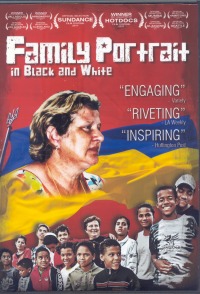| ________________
CM . . .
. Volume XIX Number 19. . . .January 18, 2013
excerpt:
Extreme xenophobic sentiments of this type are not uncommon in Eastern Europe; fan violence, racist taunts, and general hooliganism were real threats for non-white soccer players at the Euro 2012 European soccer championship held in Ukraine. Non-whites in Ukraine are truly a visible minority, and mixed-race children are near-pariahs. However, living in a small village in northeastern Ukraine is Olga Nenya, a woman who is willing to be foster mother to a brood of orphans which include 16 Ukrainian-African children of varying ages. These kids are the products of relationships between young Ukrainian women and African men (usually, students at universities in Ukraine); Olga states that “most mothers and grandmothers would be horrified if their daughters brought home a mixed-race child.” As a result, these children are abandoned to the state orphanage system, institutions from which Olga has chosen to retrieve them. The house in which they live has been purchased with money supplied by a charity headquartered in England, “Hope and Homes for Children.” The place has no in-house toilet or running hot water, and life is a daily grind of chores: working in the garden, feeding goats, geese and other farm animals, helping with the herculean task of cooking for and feeding a huge household. Nevertheless, these children do find time for play, swimming in the local river, exploring in the nearby forest, hanging out with each other, listening to music and playing cards. Still, life at home is far from harmonious. Neighbourhood kids pick fights with and taunt the mixed-race kids with racial slurs. Olga wages a running battle with inspectors from the state’s social services who are quick to point out numerous examples of her house’s inadequate living standards. And particularly as they experience adolescence, some of the children chafe at Olga’s strict and often dictatorial parenting style. Having grown up in the era of strong central Soviet helmsmen, Olga understands the concept of a controlling leader and embraces it completely. She is a strong woman, with a strong personal sense of mission for the raising of children that no one else may want, but she does not believe that children need freedom or too much spare time on their hands. For some of the kids, summer is not just a break from school, but a real vacation from the chores of home. Since the Chernobyl disaster of 1986, many European families host Ukrainian children during the summer, and viewers see that two of the children, Roman and Anya, thoroughly enjoy the time that they spend with their Italian host families. Roman’s host father would love to adopt him, but Italian law forbids a single man from doing so. While enjoying her morning espresso, Anya comments that, back home in the village, she’d be working in the garden or the kitchen. Here, she enjoys swimming at the seaside and a life of comparative luxury. However, Olga is completely negative towards the notion of relinquishing these children to a more comfortable life: “children are too precious to give away to other countries who want to adopt them.” As she sees it, Ukraine needs them and their abilities. But, some of the kids have real problems - learning disabilities, severe behavioral problems, or just an unwillingness to tow Olga’s line - and it is hard to know how they will fare in adulthood. Family Portrait in Black and White offers perspectives on the concept of “family”, insights into the nature of racism in an overtly xenophobic society, and portraits of children who manage to develop strength in the face of adversity. The film won “Best Canadian Feature” at the 2011 HotDocs Film Festival and has been presented at the prestigious Sundance Film Festival. As a documentary, it is a powerful piece of film. However, I think that it has limited applications in a secondary school setting. The 85 minute running time of the single DVD is too long for most high school class periods (and the distributor pricing information provided indicated that no PPR is provided for the single DVD, priced at $49.95), the Educational Double DVD set contains an additional shorter, edited version, running at 52 minutes, but the Educational Double DVD set is considerably more expensive at $250 plus shipping. Both versions of the film are completely sub-titled in English; with a few exceptions, all spoken audio content is in Russian (and not Ukrainian, as might have been expected). Teachers of high school courses in Sociology might find the film useful, and, certainly, schools with a strong human rights curriculum might find an occasion to screen the film. If possible, preview the film before purchase and give careful consideration as to how the film will be used in your local context. Recommended with reservations. Joanne Peters, a retired teacher-librarian, lives in Winnipeg, MB.
To comment
on this title or this review, send mail to cm@umanitoba.ca.
Copyright © the Manitoba Library Association. Reproduction for personal
use is permitted only if this copyright notice is maintained. Any
other reproduction is prohibited without permission.
NEXT REVIEW |
TABLE OF CONTENTS FOR THIS ISSUE
- January 18, 2013.
AUTHORS |
TITLES |
MEDIA REVIEWS |
PROFILES |
BACK ISSUES |
SEARCH |
CMARCHIVE |
HOME |
